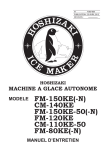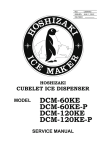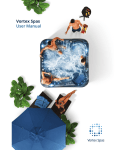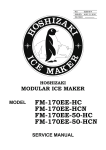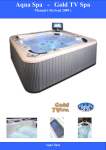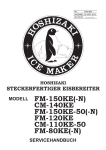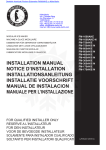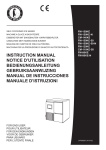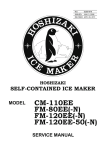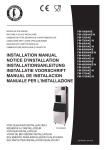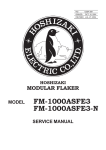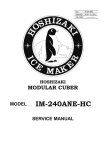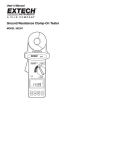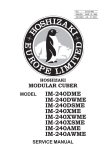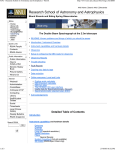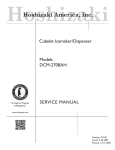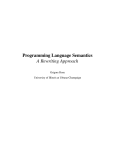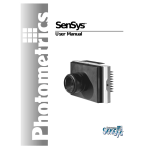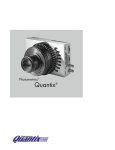Download FM-150KE(-N)
Transcript
NO. F080-869 ISSUED: APR. 25, 2012 REVISED: HOSHIZAKI SELF-CONTAINED ICE MAKER MODEL FM-150KE(-N) CM-140KE FM-150KE-50(-N) FM-120KE CM-110KE-50 FM-80KE(-N) SERVICE MANUAL CONTENTS PAGE I. SPECIFICATIONS -------------------------------------------------------------------------------------- 1 1. DIMENSIONS/SPECIFICATIONS ----------------------------------------------------------------- 1 [a] FM-150KE ------------------------------------------------------------------------------------------- 1 [b] FM-150KE-N ---------------------------------------------------------------------------------------- 2 [c] CM-140KE ------------------------------------------------------------------------------------------- 3 [d] FM-150KE-50 --------------------------------------------------------------------------------------- 4 [e] FM-150KE-50-N ------------------------------------------------------------------------------------ 5 [f] FM-120KE -------------------------------------------------------------------------------------------- 6 [g] CM-110KE-50 --------------------------------------------------------------------------------------- 7 [h] FM-80KE --------------------------------------------------------------------------------------------- 8 [i] FM-80KE-N ------------------------------------------------------------------------------------------- 9 2. CONSTRUCTION -------------------------------------------------------------------------------------10 [a] FM-150KE(-N), CM-140KE, FM-150KE-50(-N), FM-120KE, CM-110KE-50 -------10 [b] FM-80KE(-N) ---------------------------------------------------------------------------------------11 II. MAINTENANCE AND CLEANING INSTRUCTIONS -----------------------------------------12 1. EXTRUDING HEAD (UPPER BEARING), HOUSING (LOWER BEARING) -----------12 2. MECHANICAL SEAL ---------------------------------------------------------------------------------12 3. GEAR MOTOR-----------------------------------------------------------------------------------------13 4. CONDENSER (AIR-COOLED MODEL ONLY) ------------------------------------------------13 5. AIR FILTER (AIR-COOLED MODEL ONLY) ---------------------------------------------------13 6. CONTROL WATER VALVE ------------------------------------------------------------------------14 7. CLEANING OF WATER SYSTEM ----------------------------------------------------------------15 III. TECHNICAL INFORMATION----------------------------------------------------------------------18 1. WATER CIRCUIT AND REFRIGERANT CIRCUIT -------------------------------------------18 [a] FM-150KE(-N), CM-140KE, FM-150KE-50(-N), FM-120KE, CM-110KE-50 -------18 [b] FM-80KE(-N) ---------------------------------------------------------------------------------------19 2. WIRING DIAGRAM -----------------------------------------------------------------------------------20 [a] WIRING DIAGRAM -------------------------------------------------------------------------------20 [b] CONTROL BOX LAYOUT ----------------------------------------------------------------------22 3. ICEMAKING MECHANISM -------------------------------------------------------------------------23 [a] EVAPORATOR (CASING)----------------------------------------------------------------------24 [b] AUGER ----------------------------------------------------------------------------------------------24 [c] EXTRUDING HEAD (BEARING) --------------------------------------------------------------24 [d] HOUSING-------------------------------------------------------------------------------------------24 [e] MECHANICAL SEAL-----------------------------------------------------------------------------24 [f] COUPLING (SPLINE JOINT) -------------------------------------------------------------------24 [g] GEAR MOTOR ------------------------------------------------------------------------------------24 [h] BELT HEATER ------------------------------------------------------------------------------------25 [i] REMOVABLE FLANGE --------------------------------------------------------------------------25 [j] SEALING BOLT ------------------------------------------------------------------------------------25 4. ELECTRIC CIRCUIT ---------------------------------------------------------------------------------26 [a] BASIC OPERATION -----------------------------------------------------------------------------26 [b] TIMING CHART -----------------------------------------------------------------------------------27 5. OPERATION BOARD --------------------------------------------------------------------------------28 [a] OPERATION BUTTONS ------------------------------------------------------------------------28 i [b] SETTING MODEL NUMBER-------------------------------------------------------------------28 [c] DISPLAYING COMPRESSOR OPERATING HOURS, CYCLE TIME, MODEL NUMBER AND SOFTWARE VERSION -----------------------------------------------------29 [d] DISPLAYING ERROR LOG --------------------------------------------------------------------31 [e] RESETTING ERROR LOG ---------------------------------------------------------------------32 [f] RESETTING COMPRESSOR OPERATING HOURS ------------------------------------32 [g] REDUCING COMPRESSOR STARTING TIME-------------------------------------------32 6. PROTECTORS ----------------------------------------------------------------------------------------33 [a] INDICATION ---------------------------------------------------------------------------------------33 7. ERROR CODES ---------------------------------------------------------------------------------------34 8. PERFORMANCE DATA -----------------------------------------------------------------------------36 [a] FM-150KE, FM-150KE-50 ----------------------------------------------------------------------36 [b] FM-150KE-N, FM-150KE-50-N ----------------------------------------------------------------37 [c] CM-140KE ------------------------------------------------------------------------------------------38 [d] FM-120KE ------------------------------------------------------------------------------------------39 [e] CM-110KE-50 --------------------------------------------------------------------------------------40 [f] FM-80KE ---------------------------------------------------------------------------------------------41 [g] FM-80KE-N -----------------------------------------------------------------------------------------42 IV. SERVICE DIAGNOSIS -----------------------------------------------------------------------------43 1. NO ICE PRODUCTION ------------------------------------------------------------------------------43 2. LOW ICE PRODUCTION----------------------------------------------------------------------------45 3. OTHERS-------------------------------------------------------------------------------------------------45 V. REMOVAL AND REPLACEMENT OF COMPONENTS-------------------------------------47 1. SERVICE FOR REFRIGERANT LINES ---------------------------------------------------------47 [a] SERVICE INFORMATION ----------------------------------------------------------------------47 [b] REFRIGERANT RECOVERY------------------------------------------------------------------48 [c] EVACUATION AND RECHARGE-------------------------------------------------------------48 2. BRAZING ------------------------------------------------------------------------------------------------50 3. COMPRESSOR----------------------------------------------------------------------------------------50 4. DRIER----------------------------------------------------------------------------------------------------51 5. EXPANSION VALVE ---------------------------------------------------------------------------------52 6. WATER REGULATING VALVE - WATER-COOLED MODEL ONLY --------------------53 7. EVAPORATOR ASSEMBLY -----------------------------------------------------------------------54 8. CONTROL WATER VALVE ------------------------------------------------------------------------57 9. FLUSH WATER VALVE -----------------------------------------------------------------------------57 10. CONTROLLER BOARD -----------------------------------------------------------------------------58 [a] MODIFICATION -----------------------------------------------------------------------------------58 [b] REPLACEMENT ----------------------------------------------------------------------------------58 ii I. SPECIFICATIONS 1. DIMENSIONS/SPECIFICATIONS [a] FM-150KE 1 [b] FM-150KE-N 2 [c] CM-140KE 3 [d] FM-150KE-50 4 [e] FM-150KE-50-N 5 [f] FM-120KE 6 [g] CM-110KE-50 7 [h] FM-80KE 8 [i] FM-80KE-N 9 2. CONSTRUCTION [a] FM-150KE(-N), CM-140KE, FM-150KE-50(-N), FM-120KE, CM-110KE-50 Bin Control Switch Reservoir Control Water Valve Control Box Evaporator Compressor Gear Motor Flush Water Valve Fan Motor 10 Air-Cooled Condenser [b] FM-80KE(-N) Bin Control Switch Reservoir Control Water Valve Control Box Evaporator Compressor Gear Motor Flush Water Valve Fan Motor 11 Air-Cooled Condenser II. MAINTENANCE AND CLEANING INSTRUCTIONS IMPORTANT 1. This icemaker must be maintained individually, referring to the instruction manual and labels provided with the icemaker. 2. To achieve optimum icemaker performance, the following parts need periodic inspection and maintenance: Extruding head (upper bearing) Housing (lower bearing) Mechanical seal These parts should be inspected after two years from installation or 10,000 hours of operation, whichever comes first, and once a year thereafter. Their service life, however, depends on water quality and environment. More frequent inspection and maintenance are recommended in bad or severe water conditions. 1. EXTRUDING HEAD (UPPER BEARING), HOUSING (LOWER BEARING) These parts should be replaced if a diametrical gap of more than 0.5 mm is found when at least three spots are checked by changing the direction of the auger on each bearing. It depends on the water quality and conditions, but normally the bearings should be checked for wear after a total of 8,000 - 10,000 hour operation from installation date. 0.5 mm Round Stock or Pin Gauge Auger Extruding Head Note: The clearance between the auger blades and the evaporator interior is 0.4 - 0.5 mm. If the bearings and rotating parts are worn out to create a larger clearance, the evaporator For reference only interior may be damaged. (The diameters (May differ from actual design) differ by 0.8 - 1.0 mm.) If the auger surfaces against which the bearings contact are no longer smooth or show any burrs or abrasions during the above inspection, replace the auger. 2. MECHANICAL SEAL The mechanical seal prevents water leaks from between the auger and the housing bearing and gradually wears out to reduce its watertightness. Check the amount of water leakage from the drain pipe located at the side of the gear case to determine the necessity of replacement. Total operation time 3,000 hours 10,000 hours Water leakage 0.1 mL/h 0.5 mL/h 12 Note: The water leakage will exceed the above amount with scale/dirt build up or damage on the mating surface. Replace the mechanical seal when the water leakage exceeds 0.5 mL/h. 3. GEAR MOTOR After the following hours of operation, check the gear motor for excessive noise caused by increased torque or deterioration of mechanical parts. Bearing, gear and other mechanical parts: Oil seal: 10,000 hours 5 years Note: When the output shaft oil seal is exposed to a large amount of water at one time, water may enter the gear case. Always drain the water circuit before removing the auger for service. 4. CONDENSER (AIR-COOLED MODEL ONLY) Check the condenser once a year, and clean if required by using a brush or vacuum cleaner. More frequent cleaning may be required depending on the location of the icemaker. 5. AIR FILTER (AIR-COOLED MODEL ONLY) Plastic mesh air filters remove dirt or dust from the air, and keep the condenser from getting clogged. If the filters get clogged, the icemaker’s performance will be reduced. Remove and clean the air filters at least twice per month: 1) Slide the air filter off the louver. 2) Clean the air filter by using a vacuum cleaner. When severely clogged, use warm water and a neutral cleaner to wash the air filter. 3) Rinse and dry the air filter thoroughly, and place it in position. 13 6. CONTROL WATER VALVE 1) Disconnect the power source. 2) Close the water supply tap. 3) Disconnect the inlet hose from the water valve. 4) Clean the filter packing using a brush. 5) Replace the filter packing and inlet hose in their correct positions. 6) Open the water supply tap. 7) Connect the power source. 8) Check for leaks. Control Water Valve Inlet Hose Filter Packing 14 7. CLEANING OF WATER SYSTEM WARNING 1. HOSHIZAKI recommends cleaning this unit at least twice a year. More frequent cleaning, however, may be required in some existing water conditions. 2. Do not touch the operation switch with damp hands. 3. Always wear rubber gloves, eye protectors, apron, etc. for safe handling of the cleaner and sanitiser. 4. Use the cleaners and sanitisers recommended by Hoshizaki. Contact your local Hoshizaki office for further details. (The instructions below give an example of those recommended cleaners and sanitisers.) 5. Never mix cleaning and sanitising solutions in an attempt to shorten cleaning time. 6. Wipe off any splashed or spilt cleaner/sanitiser immediately. 7. Do not use any ammonia type cleaners on any part of the icemaker. CAUTION Do not use ice produced with cleaning and sanitizing solutions. Be sure none remains in the storage bin on completion of cleaning. <STEP 1> Dilute the solutions with water as follows: Cleaning solution: “Nickel-Safe Ice Machine Cleaner” by The Rectorseal Corporation or similar. Prepare approximately 3 L of solution as directed on the container. Sanitising solution: 30 mL of 5.25% sodium hypochlorite with 7.6 L of water or the Hoshizaki recommended sanitiser as directed on the container. IMPORTANT For safety and maximum effectiveness, use the solutions immediately after dilution. <STEP 2> Use the cleaning solution to remove lime deposits in the water system. 1) Open the plastic access flap on the front panel. 2) Press the stop button to activate the flush cycle (approx. 10 minutes). 15 3) Remove all ice from the storage bin to avoid contamination by the cleaner. 4) Unplug the icemaker. Remove the top and front panels. 5) Remove the cover of the reservoir. Remove any loose debris or scale. 6) Carefully fill the reservoir with the solution to the overflow point. If necessary, use a small brush to clean the inside of the reservoir. 7) Refit the reservoir cover. 8) Check that the operation switch is in the “ON” position. 9) Refit the front and top panels. 10) Allow the icemaker to stand for about 10 minutes, then plug in the icemaker to make ice with the solution. 11) With the water supply tap open, allow the machine to continue icemaking for a further 20 minutes. Open the access flap and press the stop button. 12) Allow time for the gear motor to stop and the water system to drain. 13) Allow the icemaker to make ice for approximately 10 minutes. 14) Pour warm water into the storage bin to melt any ice down the drain. Note: 1. If the machine has heavy deposits of scale, repeat the complete cleaning procedure. 2. Do not increase the proportion of cleaning solution to shorten cleaning times, as this may lock the auger when completing item 10). <STEP 3> Note: Sanitising should always be completed after cleaning or alternately as an individual procedure if conditions exist to make it necessary. Use 2.8 litres of the sanitising solution to sanitise the icemaker. 15) Follow items 1) to 14) to complete sanitisation of the water system. <STEP 4> Use the remaining sanitising solution to sanitise removable parts. 16) Open the door and remove the actuator assembly from the upper panel by pushing the tabs on the actuator base inward. 17) Remove the reed switch and the actuator from the actuator base. 18) Remove the thumbscrews, the spout and the spout gasket. 16 19) Immerse these parts in the sanitizing solution for about 15 minutes. 20) Rinse these parts thoroughly with clean water. IMPORTANT If the solution is left on these parts, they will corrode. 21) Refit the removed parts in reverse order. 22) Close the water supply tap. Tab Actuator Base Actuator To remove actuator, make it horizontal and push in arrow direction Actuator Reed Switch Spout Gasket Thumbscrew Spout 17 III. TECHNICAL INFORMATION 1. WATER CIRCUIT AND REFRIGERANT CIRCUIT [a] FM-150KE(-N), CM-140KE, FM-150KE-50(-N), FM-120KE, CM-110KE-50 CONTROL WATER VALVE RESERVOIR WATER VALVE EXPANSION VALVE WATER SUPPLY EVAPORATOR FLUSH WATER VALVE GEAR MOTOR DRAIN PAN DRIER CAPILLARY TUBE FAN MOTOR DRAIN COMPRESSOR FAN CONDENSER AIR-COOLED 18 [b] FM-80KE(-N) CONTROL WATER VALVE EVAPORATOR GEAR MOTOR FLUSH WATER VALVE DRAIN PAN DRIER CAPILLARY TUBE FAN MOTOR DRAIN COMPRESSOR FAN CONDENSER AIR-COOLED 19 700mm WATER SUPPLY HEAT EXCHANGER RESERVOIR WATER VALVE 2. WIRING DIAGRAM [a] WIRING DIAGRAM FM-150KE(-N), CM-140KE, FM-150KE-50(-N), FM-120KE, CM-110KE-50 20 FM-80KE(-N) 21 [b] CONTROL BOX LAYOUT OB SA2 CB X5 F S3 X1 X3 X2 X4 CB OB X1 X2 X3 X4 X5 S3 OL SA2 F CONTROLLER BOARD - MAIN CONTROLLER BOARD - OPERATION POWER RELAY (CONTROL WATER VALVE, ON BOARD) POWER RELAY (FLUSH WATER VALVE, ON BOARD) POWER RELAY (GEAR MOTOR, ON BOARD) POWER RELAY (COMPRESSOR, ON BOARD) POWER RELAY (GM DRIVE DETECTOR) OPERATION SWITCH CIRCUIT PROTECTOR (10A) SURGE ABSORBER (LIGHTENING ARRESTER) FUSE 3.15A 22 OL 3. ICEMAKING MECHANISM CM-110KE CM-140KE Sealing Bolt Cutter Flange FM-80KE FM-120KE FM-150KE(-50) FM-80KE-N FM-150KE(-50)-N Extruding Head Cutter Cutter Extruding Head Extruding Head Evaporator Screw Hex Head Bolt w/Washer Auger O-Ring Housing Ring Coupling - Spline Mechanical Seal Gear Motor 23 [a] EVAPORATOR (CASING) The evaporator consists of a stainless steel icemaking cylinder coiled with a refrigeration pipe and wrapped together with a polyurethane foam insulation material. Water coming from the inlet into the evaporator will be frozen into ice. The ice spout is located on top of the evaporator. [b] AUGER The stainless steel auger is supported by the upper and lower bearings of the evaporator and slowly rotated by the gear motor, while scraping off the ice forming on the inner wall of the cylinder and pushing up to the ice spout. [c] EXTRUDING HEAD (BEARING) The stainless steel extruding head is provided with a press-fit plastic bearing inside and fixed on top of the evaporator. The extruding head functions as the auger bearing and compresses the sherbet ice carried up by the auger into a column shape with the path resistance. [d] HOUSING The cast bronze housing is provided with a press-fit plastic bearing inside and fixed on the bottom of the evaporator for connection with the gear motor. [e] MECHANICAL SEAL The mechanical seal on the lower auger bearing prevents icemaking water leaks into the evaporator. The mating surfaces are made of ceramic and carbon. [f] COUPLING (SPLINE JOINT) The auger bottom and gear motor output shaft are splined and connected with the spline joint. [g] GEAR MOTOR The gear motor consists of a 200W 1 phase 240V or 80W 1 phase 220 - 240 / 220V drive motor integrated with a decelerator and provided with a built-in auto-reset thermal protector. When the thermal protector trips, the controller board will stop the gear motor. The thermal protector trips when the gear motor mechanism is overloaded or when excessively high or low voltage is applied on the gear motor. The electrical capacity must be increased if a large current flows through the surrounding equipment. 24 [h] BELT HEATER (provided on some models) The belt heater is provided to reduce the load of ice passing the extruding head during a freeze cycle and to prevent vapor lock during a flush cycle. [i] REMOVABLE FLANGE The flange used to be welded on the evaporator to fix the spout. But sometimes the extruding head applies excessive load on the evaporator to compress ice, resulting in breaking the welded joints. To avoid the load, the flange has been changed to a separate part to be secured together with the extruding head by using sealing bolts. [j] SEALING BOLT Sometimes the icemaking operation may produce white solids on the drip pan. They are deposits of silica and calcium contents in the icemaking water leaking from the sealing bolt. The bolt is provided with retaining and sealing functions, which may be reduced by the load and vibration during a freeze cycle. Do not reuse a removed sealing bolt. Solids deposited from sealing bolt 25 4. ELECTRIC CIRCUIT CAUTION Reassemble all the components as they were after servicing the unit according to a service call. [a] BASIC OPERATION The icemaker starts water supply when the operation switch is moved to the “ON” position. On completion of water supply, the gear motor starts immediately. After 5 minutes the compressor starts to begin icemaking operation. In normal operation, the icemaker shuts down when the storage bin fills up to trip the bin control switch or the stop button is pressed. When the compressor operates for 6 hours in total and continuously for more than 10 minutes, the icemaker supplies water until the reservoir fills up and starts a drain cycle. After 10 minutes the icemaker automatically starts water supply and resumes icemaking operation. 26 [b] TIMING CHART 27 5. OPERATION BOARD [a] OPERATION BUTTONS ICE = When pressed in the STOP mode, the unit is supplied with water and starts icemaking operation. STOP = When pressed in the ICE mode, the unit stops icemaking operation and drains. MAINTENANCE A = Used for various maintenance operations. MAINTENANCE B = Used for model code setting. OPERATION SWITCH = Power supply for the icemaker. Move it to the “OFF” position to shut down the unit for a long time. [b] SETTING MODEL NUMBER The model number must be set at the time of replacement of the controller board. Check the model number specified on the wiring label. Improper setting may result in failure or inoperability. 1) Press and hold the maintenance B button, and move the operation switch to the “ON” position. 2) When the display shows “99”, release the maintenance B button. 3) Press the stop button to increase the number, or press the ice button to decrease the number until it matches the model number on the wiring label. 4) Press the maintenance B button to complete the setting and start icemaking operation in the ice mode. 5) To check the model number, see next page. 28 3) 2) 4) 1) [c] DISPLAYING COMPRESSOR OPERATING HOURS, CYCLE TIME, MODEL NUMBER AND SOFTWARE VERSION Press and hold the maintenance A button, and press the ice button. The display shows the following items one by one every time the ice button is pressed. This function is available in the ice or stop mode. Press and hold MAINTENANCE A Compressor operating hours on display -------Press ICE Cycle time on display ---------------------------------Press ICE Model number on display----------------------------Press ICE Software version on display ------------------------Release MAINTENANCE A 29 a) b) c) d) Note: 1. The display shows the next item if the ice button is pressed before one item appears in the display. 2. The display mode is cancelled if the maintenance A button is released. 3. The software version is displayed repeatedly while the maintenance A button is pressed. Release the maintenance A button to cancel the display mode. a) Compressor Operating Hours The display shows the compressor operating hours in six digits divided into three parts (2 digits for 2 seconds each time). Then, “- -“ appears in the display (to show the end of the compressor operating hours display mode). e.g. 3527 hours = “00”, “35”, “27”, “- -“ b) Cycle Time The display shows the cycle time in four digits divided into two parts (first minutes then seconds, for 2 seconds each time) from the latest record (5 records at maximum). Then, “- -“ appears in the display (to show the end of the cycle time display mode). If no cycle time is recorded, the display shows “- -“ only. Minutes are indicated as follows: o 0 to 9 = 0 to 9 minutes A 0 to 9 = 10 to 19 minutes b 0 to 9 = 20 to 29 minutes C 0 to 9 = 30 to 39 minutes d 0 to 9 = 40 to 49 minutes E 0 to 9 = 50 to 59 minutes Seconds are indicated as 0 to 5 0 to 9. e.g. o9 48 = 9 minutes 48 seconds b7 36 = 27 minutes 36 seconds By using the freeze cycle time, approximate ice production capacity can be calculated. Series FM-80 FM-120 CM-110 FM-150 CM-140 FM-170 FM-300 FM-480 FM-600 FM-750 FM-1000 FM-1200 Approximate ice production capacity (kg/d) 60,000 / cycle time (sec) 85,000 / cycle time (sec) This is just an approximate capacity. The actual capacity depends on ambient temperature, water temperature, voltage and frequency. 30 For accurate measurement, use a container to receive ice actually produced for 10 minutes, measure its weight, and calculate ice production per day. Repeat this three times to figure out the average. c) Model Number The display shows two digits. e.g. FM-750AKE(-N), FM-1000AKE(-N) = “05” d) Software Version The display shows the software version in six digits/symbols divided into three parts. e.g. Ver. 9-3-6 = “09”, “-3”, “-6” The indication is repeated until the maintenance A button is released. [d] DISPLAYING ERROR LOG Press and hold the maintenance A button, and press the stop button. The display shows the following items one by one every time the stop button is pressed. This function is available in the ice or stop mode. Press and hold MAINTENANCE A Compressor operating hours on display -------- [c] a) Press STOP Error log on display (8 records at maximum) Press STOP “- -“ on display (end of error log display mode) Press STOP Ongoing error on display Release MAINTENANCE A Note: 1. The display does not show the ongoing error even if the stop button is pressed while the error log is in the display. To display the ongoing error, press the stop button while “- -“ is in the display to show the end of the error log display mode 31 [e] RESETTING ERROR LOG With the operation switch in the “OFF” position, press and hold the stop and maintenance A buttons. Move the operation switch to the “ON” position. Release the buttons when the display shows the ice mode. Now the error log is reset. Do not reset more than necessary. [f] RESETTING COMPRESSOR OPERATING HOURS With the power switch turned off, press and hold the ice, stop and maintenance A buttons. Move the operation switch to the “ON” position. Release the buttons when the display shows the ice mode. Now the compressor operating hours are reset. When the compressor starts in 15 seconds after the water supply cycle ends, the error log is not set to be updated. After resetting the compressor operating hours, move the operation switch to the “OFF” position, turn off the power switch, and turn it back on. [g] REDUCING COMPRESSOR STARTING TIME With the power switch turned off, press and hold the maintenance A button. Move the operation switch to the “ON” position. Release the button when the display shows the ice mode. The compressor starts in 30 seconds after the water supply cycle ends 32 6. PROTECTORS [a] INDICATION When an error occurs, “E_” or ”c_” will appear in the display. Some of the “c_” errors are not displayed and must be checked by the error log. When an operational error occurs, “E_” will appear and blink in the display on the operation board, and the icemaker will stop. When a service call is received, ask the user to check which error code is in the display. Then, see the error code table in “7. ERROR CODES” to locate the cause. 33 7. ERROR CODES Interlock Errors Code Error Condition Operation Reset E0 Icemaking Water Leak c0 error occurs 2 times in a row. Whole unit stops. Power supply, Turn OFF Turn ON E1 Low Ice Production Icemaking cycle takes too long. Whole unit stops. Power supply, Turn OFF Turn ON Whole unit stops. Power supply, Turn OFF Turn ON Whole unit stops. Power supply, Turn OFF Turn ON E4 blinks. N/A With flush water valve OFF, float switch trips at both upper and lower float levels for 2 seconds. Gear motor is ON with rotation sensor or current sensor circuit open. Gear motor relay is ON with gear motor protective circuit detector OFF. Check/Repair Water leak from water circuit (reservoir, inlet hose, outlet hose, hose joint, mechanical seal, flush water valve), float switch Gas leak, control water valve not closing, vapor lock, freeze, float switch E2 Float Switch Error E3 Gear Motor Error or Gear Motor Sensor Circuit Open E4 Abnormal High Side Pressure c2 error occurs 5 times in 1 hour of compressor operation. Gear Motor Drive Element Error Gear motor is OFF on controller board while rotation sensor signals Whole unit gear motor rotation or stops. current flows. Gear motor relay is OFF with gear motor protective circuit detector ON. Power supply, Turn OFF Turn ON Miswiring, gear motor magnet switch or relay Replace controller board. Discharge pipe thermostat is OFF. Whole unit stops. Power supply, Turn OFF Turn ON Gas leak, compressor cooling fan failure Water thermistor circuit is open. EA blinks. N/A Water thermistor Condenser thermistor circuit is open. Whole unit stops. Evaporator outlet thermistor circuit is open. Whole unit stops. E5 E8 EA Eb EC EE Discharge Pipe Temperature Error Water Thermistor Circuit Open Condenser Thermistor Circuit Open Evaporator Outlet Thermistor Circuit Open Gear Motor Error Rotation sensor detects reversing. c5 error occurs 5 times. Power supply, Turn OFF Turn ON Power supply, Turn OFF Turn ON Float switch Rotation sensor, current sensor Gear motor protective circuit (TPO, overload, etc.), gear motor relay Fan motor, cooling water circuit, refrigeration circuit, condenser clogged, water supply, installation conditions Condenser thermistor Evaporator outlet thermistor Whole unit stops. Power supply, Turn OFF Turn ON Gear motor locked, hunting or overloaded, supply voltage, high ambient temperature EF Abnormal Low Voltage c3 error occurs 3 times in 24 hours. Whole unit stops. Power supply, Turn OFF Turn ON Supply voltage EH Discharge Pipe Thermistor Circuit Open Discharge pipe thermistor circuit is open. EH blinks. N/A Discharge pipe thermistor EL Bin Control Switch Error Bin control protective switch trips. Whole unit stops. Power supply, Turn OFF Turn ON Bin control switch 34 Code En EU None Error Low Voltage Sensing Transformer Circuit Open Condition Operation Reset Low voltage sensing transformer circuit is open. Whole unit stops. Power supply, Turn OFF Turn ON Controller Board Error Controller board IC fails. Whole unit stops. Electric Leak Short Circuit Electric leak or overcurrent. Whole unit stops. Power supply, Turn OFF Turn ON Power supply, Turn OFF Turn ON Replace fuse Check/Repair Low voltage sensing Transformer Replace controller board. Electric leak, fuse Non-Interlock Errors Code Error CM Microcomputer Time Read/Write “- -” Error c0 Icemaking Water Leak c1 Low Water c2 Abnormal High Side Pressure c3 Abnormal Low Voltage c4 Drain Error c5 Gear Motor Error c7 Evaporator Outlet Temperature Decrease Condition Operation Check/Repair Error records and Microcomputer fails to Memory circuit Replace compressor read/write properly. not available. controller board. operating hours not available on display Whole unit stops. Water leak from After initial water supply, Flush water water circuit float switch trips at lower valve turns ON (reservoir, hoses, Error record only. float level within 5 minutes for 1 second, mechanical seal, after gear motor starts and then turns OFF. flush water valve), before compressor starts. Unit restarts. float switch Water supply continues for Whole unit stops Water supply more than 90 seconds, or until reservoir fills interruption, control float switch trips at lower up. Only control Automatically water valve not resets after float level and does not water valve opening, flush reset for more than 60 operates reservoir fills up. water valve not seconds after water intermittently for closing, float supply. 5 minutes. switch, water leak Automatically resets after Pressure switch stays pressure switch Condenser OFF for 5 seconds or turns ON or clogged, cooling condenser thermistor Whole unit stops. water circuit, condenser reads higher than set point thermistor reads refrigeration circuit for 5 seconds. lower than set point. Automatically Voltage stays below resets after setting for more than 1 voltage stays Supply voltage second with compressor Whole unit stops. above reset ON and control water setting for 2 valve OFF. minutes. Flush water valve Float switch trips at upper not opening, control float level in 10 minutes N/A Error record only. water valve not after flush water valve closing turns ON. Rotation rate reduces. Automatically While gear motor is Gear motor running, voltage detection Whole unit stops. resets after 30 overloaded minutes. signal is not input to controller board. Evaporator inside Automatically not clean, extruding Evaporator outlet Indication only. resets. temperature decreases. head not clean, heater circuit open 35 Reset 8. PERFORMANCE DATA [a] FM-150KE, FM-150KE-50 3 0.14 140 120 0.12 100 0.10 80 20 30 40 0 10 20 30 40 5.2 17 5.1 16 5 15 4.9 14 4.8 13 0 Head Pressure [kPa] 10 10 20 30 40 0 10 20 30 40 1300 80 1100 60 900 40 700 20 500 0 0 10 20 30 40 0 10 20 30 The horizontal axis shows the ambient temperature. It refers to the data of at/wt=10/10,21/15,32/21,40/35. 36 Wattage [kWh/day] Amperage [A] 0 40 Suction Pressure [kPa] Ice Production Capacity [kg/day] 160 Water Consumption [m /day] 0.16 180 160 140 0.14 130 0.12 120 110 0.10 100 90 0.08 80 10 20 30 0 40 10 20 30 40 5.2 17 5.1 16 5 15 4.9 14 4.8 13 0 10 20 30 40 0 10 20 30 40 1300 80 1100 60 900 40 700 20 500 0 0 10 20 30 40 0 10 20 30 40 The horizontal axis shows the ambient temperature. It refers to the data of at/wt=10/10,21/15,32/21,40/35. 37 Wattage [kWh/day] Amperage [A] 0 Head Pressure [kPa] 3 150 Water Consumption [m /day] 0.16 Suction Pressure [kPa] Ice Production Capacity [kg/day] [b] FM-150KE-N, FM-150KE-50-N 140 0.14 120 0.12 100 0.10 80 0.08 0 10 20 30 40 0 10 20 30 40 17 16 5.1 15 5 14 4.9 Wattage [kWh/day] Amperage [A] 5.2 13 0 Head Pressure [kPa] 3 0.16 Water Consumption [m /day] 160 10 20 30 40 0 10 20 30 40 1300 80 1100 60 900 40 700 20 500 0 0 10 20 30 40 0 10 20 30 The horizontal axis shows the ambient temperature. It refers to the data of at/wt=10/10,21/15,32/21,40/35. 38 40 Suction Pressure [kPa] Ice Production Capacity [kg/day] [c] CM-140KE 140 0.14 120 0.12 100 0.10 80 0.08 0 10 20 30 0 40 10 20 30 40 14 3.4 13 3.3 12 3.2 3.1 Wattage [kWh/day] Amperage [A] 3.5 11 0 10 20 30 40 0 10 20 30 40 1300 Head Pressure [kPa] 3 0.16 Water Consumption [m /day] 160 100 1100 80 900 60 700 500 40 0 10 20 30 40 0 10 20 30 40 The horizontal axis shows the ambient temperature. It refers to the data of at/wt=10/10,21/15,32/21,40/35. 39 Suction Pressure [kPa] Ice Production Capacity [kg/day] [d] FM-120KE 150 3 130 0.12 110 0.10 90 0.08 70 10 20 30 40 0 10 20 30 40 3.5 14 3.4 13 3.3 12 3.2 11 0 10 20 30 40 0 10 20 30 Wattage [kWh/day] Amperage [A] 0 40 1200 Head Pressure [kPa] Water Consumption [m /day] 0.14 100 1000 80 800 60 600 400 40 0 10 20 30 40 0 10 20 30 40 The horizontal axis shows the ambient temperature. It refers to the data of at/wt=10/10,21/15,32/21,40/35. 40 Suction Pressure [kPa] Ice Production Capacity [kg/day] [e] CM-110KE-50 90 0.09 80 0.08 70 0.07 60 0.06 50 0.05 10 20 30 40 0 10 20 30 40 Amperage [A] 1.85 7 1.8 6.5 1.75 6 1.7 5.5 1.65 0 10 20 30 40 0 10 20 30 40 140 1000 Head Pressure [kPa] Wattage [kWh/day] 0 3 0.1 Water Consumption [m /day] 100 120 800 100 600 80 400 60 200 40 0 10 20 30 40 0 10 20 30 The horizontal axis shows the ambient temperature. It refers to the data of at/wt=10/10,21/15,32/21,40/35. 41 40 Suction Pressure [kPa] Ice Production Capacity [kg/day] [f] FM-80KE 70 0.07 60 0.06 50 0.05 40 0.04 30 0.03 3 0.08 0 10 20 30 0 40 10 20 30 40 7 1.75 6.5 1.7 6 1.65 5.5 1.6 0 10 20 30 0 40 10 20 30 40 1000 140 800 120 100 600 80 400 60 40 200 0 10 20 30 0 40 10 20 30 The horizontal axis shows the ambient temperature. It refers to the data of at/wt=10/10,21/15,32/21,40/35. 42 Wattage [kWh/day] Amperage [A] 1.8 Head Pressure [kPa] Water Consumption [m /day] 80 40 Suction Pressure [kPa] Ice Production Capacity [kg/day] [g] FM-80KE-N IV. SERVICE DIAGNOSIS Display error records by operating the operation board (see “III. 5. [d] DISPLAYING ERROR LOG”). Check for a possible cause and service the unit. 1. NO ICE PRODUCTION PROBLEM [1] The icemaker will not start. POSSIBLE CAUSE a) Power supply 1. OFF position. 2. Loose connections. 3. Bad contacts. b) Fuse c) Transformer receptacle d) Operation switch 4. Blown fuse. 5. Voltage too low. 1. Blown out. No indication on operation board. 1. Disconnected. 1. OFF position. 2. Bad contacts. e) Transformer f) Water valve g) Water supply tap 1. Coil winding opened. 1. Coil winding opened. 1. Closed. 2. Water failure. h) Plug and 1. Disconnected. receptacle (control 2. Terminal out of plug box) or receptacle. i) Reed switch 1. Tripped. (spout) j) Overload protector 1. Tripped. k) Model number 1. Incorrect. [2] Water does not stop, and the icemaker will not start. a) Water control relay (controller board) b) Float switch c) Flush water valve [3] Water has been supplied, but the icemaker will not start. d) Hoses e) Mechanical seal f) Reservoir a) Bin control b) Gear motor protector (thermal breaker) c) Controller board 1. Contacts fused. 2. Coil winding opened. 1. Bad contacts. 2. Float does not move freely. 1. Valve seat clogged and water leaking. 1. Disconnected. 1. Water leaks. 1. Cracked. 1. Bad contacts. 1. Tripped. 1. Defective. 43 REMEDY 1. Move to ON position. 2. Tighten. 3. Check for continuity and replace. 4. Replace. 5. Get recommended voltage. 1. Locate and resolve the cause of short circuit (ex. control water valve, flush water valve), and replace. 1. Connect. 1. Move to ON position. 2. Check for continuity and replace. 1. Replace. 1. Replace. 1. Open. 2. Wait till water is supplied. 1. Connect. 2. Insert terminal back in position. 1. See 1 - [3] - a). 2. Reset. 2. Set correct number. See “III. 5. [b] SETTING MODEL NUMBER”. 1. Replace controller board. 2. Replace controller board. 1. Check for continuity and replace. 2. Clean or replace. 1. Clean or replace. 1. Connect. 1. Replace. 1. Replace. 1. Check for continuity and replace. 1. Find out the cause, resolve it, and press reset button on motor protector. 1. Replace. PROBLEM [3] (Continued) POSSIBLE CAUSE d) Pressure switch, 1. Dirty condenser fins. condenser 2. Ambient temperature thermistor too warm. 3. Fan not rotating. 4. Condenser water pressure too low or off. 5. Water regulating valve clogged. 6. Refrigerant overcharged. 7. Refrigerant line or components plugged. 8. Bad contacts. e) Thermostat (water-cooled model) f) Gear motor protect relay [4] Gear motor starts, but compressor will not start or operates intermittently. a) X4 relay (controller board) b) X6 relay b) Compressor c) Power supply [5] Gear motor and compressor start, but no ice is produced. d) Controller board e) Start capacitor or run capacitor a) Refrigerant line 9. Loose connections. 1. Ambient temperature too warm. 2. Compressor cooling fan motor defective. 3. Bad contacts. 4. Loose connections. 1. Coil winding opened. 2. Bad contacts. 1. Bad contacts. 2. Coil winding opened. 1. Bad contacts. 2. Coil winding opened. 1. Loose connections. 2. Motor winding opened or earthed. 3. Motor protector tripped. 1. Circuit ampacity too low. 1. Defective. 1. Defective. 1. Gas leaks. 2. Refrigerant line clogged. 44 REMEDY 1. Clean. 2. Check for recommended temperature. 3. Replace. 4. Check and get recommended pressure. 5. Clean. 6. Recharge. 7. Clean and replace drier. 8. Check for continuity and replace. 9. Tighten. 1. Check for recommended temperature. 2. Replace. 3. Check for continuity and replace. 4. Tighten. 1. Replace. 2. Check for continuity and replace. 1. Check for continuity and replace controller board. 2. Replace controller board. 1. Check for continuity and replace X6 relay. 2. Replace X6 relay. 1. Tighten. 2. Replace. 3. Find out the cause of overheat or overcurrent. 1. Install a larger-sized conductor. 1. Replace 1. Replace 1. Check for leaks with a leak detector. Reweld leak, replace drier and charge with refrigerant. The amount of refrigerant is marked on nameplate or label. 2. Replace the clogged component. 2. LOW ICE PRODUCTION PROBLEM [1] Low ice production POSSIBLE CAUSE a) Refrigerant line 1. Gas leaks. 2. Refrigerant line clogged. 3. Overcharged. b) High-side 1. Dirty air filter or pressure too high condenser. 2. Ambient or condenser water temperature too warm. 3. Condenser water pressure too low or off. 4. Fan rotating too slow. 5. Water regulating valve clogged. 6. Bad ventilation. c) Expansion valve (not adjustable) d) Evaporator 7. Less than specified clearance at rear, sides and top. 1. Low-side pressure exceeding the limit. 1. Evaporator pipe crushed. REMEDY 1. See 1 - [5] - a). 2. Replace the clogged component. 3. Recharge. 1. Clean. 2. Check for recommended temperature. 3. Check and get recommended pressure. 4. Replace. 5. Clean. 6. Remove anything blocking vents. 7. Allow proper clearance for ventilation. 1. Replace. 1. Replace. 3. OTHERS PROBLEM [1] Abnormal noise POSSIBLE CAUSE a) Fan motor 1. Bearing worn out. (condenser unit) 2. Fan blade deformed. 3. Fan blade does not move freely. b) Compressor 1. Bearings worn out, or cylinder valve defective. 2. Mounting pad out of position. c) Refrigerant lines 1. Rub or touch lines or other surfaces. d) Gear motor (ice 1. Bearing or gear making) wear/damage. e) Evaporator 1. Low-side pressure too low. f) Heater g) CPR (condenser unit) REMEDY 1. Replace. 2. Replace fan blade. 3. Replace. 1. Replace. 2. Reinstall. 1. Replace. 1. Replace. 1. See if expansion valve bulb is mounted properly, and replace the valve if necessary. 2. Scale on inside wall of 2. Remove auger. Use a solution freezing cylinder. of lime removing cleaner to clean periodically. If water is found to surpass the following levels, install a conditioner. Hardness 50 ppm Silica 30 ppm 1. Defective. 1. Replace. 1. Internal leaks. 1. Replace. 45 PROBLEM [2] Overflow from reservoir (Water does not stop.) [3] Gear motor protector operates frequently. POSSIBLE CAUSE a) Water supply 1. Water pressure too high. b) Water valve 1. Diaphragm does not close. c) Float switch 1. Bad contacts. a) Power supply voltage b) Evaporator assy 1. Too high or too low. 1. Bearings or auger worn out. 46 REMEDY 1. Install a pressure reducing valve. 1. Clean or replace. 1. Check for continuity and replace. 1. Connect the unit to a power supply of proper voltage. 1. Replace bearing or auger. V. REMOVAL AND REPLACEMENT 1. SERVICE FOR REFRIGERANT LINES [a] SERVICE INFORMATION 1) Allowable Compressor Opening Time and Prevention of Lubricant Mixture [R404A/R134A] The compressor must not be opened more than 15 minutes in replacement or service. Do not mix lubricants of different compressors even if both are charged with the same refrigerant, except when they use the same lubricant. 2) Treatment for Refrigerant Leak [R404A/R134A] If a refrigerant leak occurs in the low side of an ice maker, air may be drawn in. Even if the low side pressure is higher than the atmospheric pressure in normal operation, a continuous refrigerant leak will eventually lower the low side pressure below the atmospheric pressure and will cause air suction. Air contains a large amount of moisture, and ester oil easily absorbs a lot of moisture. If an ice maker charged with R404A/R134A has possibly drawn in air, the drier must be replaced. Be sure to use a drier designed for R404A/R134A. 3) Handling of Handy Flux [R404A/R134A] Repair of the refrigerant circuit requires brazing. It is no problem to use the same handy flux that has been used for the current refrigerants. However, its entrance into the refrigerant circuit should be avoided as much as possible. 4) Oil for Processing of Copper Tubing [R404A/R134A] When processing the copper tubing for service, wipe off oil, if any used, by using alcohol or the like. Do not use too much oil or let it into the tubing, as wax contained in the oil will clog the capillary tubing. 5) Service Parts for R404A/R134A Some parts used for refrigerants other than R404A/R134A are similar to those for R404A/R134A. But never use any parts unless they are specified for R404A/R134A because their endurance against the refrigerant have not been evaluated. Also, for R404A/R134A, do not use any parts that have been used for other refrigerants. Otherwise, wax and chlorine remaining on the parts may adversely affect R404A/R134A. 6) Replacement Copper Tubing [R404A/R134A] The copper tubes currently in use are suitable for R404A/R134A. But do not use them if oily inside. The residual oil in copper tubes should be as little as possible. (Low residual oil type copper tubes are used in the shipped units.) 47 7) Evacuation, Vacuum Pump and Refrigerant Charge [R404A/R134A] Never allow the oil in the vacuum pump to flow backward. The vacuum level and vacuum pump may be the same as those for the current refrigerants. However, the rubber hose and gauge manifold to be used for evacuation and refrigerant charge should be exclusively for R404A/R134A. 8) Refrigerant Leak Check Refrigerant leaks can be detected by charging the unit with a little refrigerant, raising the pressure with nitrogen and using an electronic detector. Do not use air or oxygen instead of nitrogen for this purpose, or rise in pressure as well as in temperature may cause R404A/R134A to suddenly react with oxygen and explode. Be sure to use nitrogen to prevent explosion. [b] REFRIGERANT RECOVERY The refrigerant must be recovered if required by an applicable law. A low-side access valve is provided in the unit (modular type only). Recover the refrigerant from the access valve, and store it in a proper container. Do not discharge the refrigerant into the atmosphere. When replacing the drier, take the opportunity to also fit a low-side access valve (self-contained type only) and a high-side access valve for ease of charging liquid refrigerant. [c] EVACUATION AND RECHARGE R134a models 1) Attach a charging hose of a gauge manifold to a vacuum pump and the low-side access valve (to be fitted by service personnel for self-contained type). 2) Open the low-side valve on the gauge manifold, and turn on the vacuum pump. 3) Allow the vacuum pump to pull down to a 760 mmHg vacuum. Evacuating period depends on the pump capacity. 4) Close the low-side valve on the gauge manifold. 5) Disconnect the vacuum pump, and attach a refrigerant charging cylinder to accurately weigh in the liquid charge. Remember to purge any air from the charging hose. See the nameplate for the required refrigerant charge. 6) Open the low-side valve on the gauge manifold and the valve on the charging cylinder. 7) When no more refrigerant is drawn in, turn on the icemaker. When the required amount of refrigerant has been charged, close the valve on the charging cylinder and turn off the icemaker. 8) Close the low-side valve on the gauge manifold. 48 9) Disconnect the charging hose from the access valve. Always cap the access valve to prevent a refrigerant leak. 10) Always thoroughly leak test all joints and valve caps. 11) Avoid charging large quantities of liquid into the low side in case of damage to the compressor. R404A models 1) Attach charging hoses of a gauge manifold to a vacuum pump, the low-side access valve and the high-side access valve (to be fitted by service personnel). 2) Open the low-side and high-side valves on the gauge manifold, and turn on the vacuum pump. 3) Allow the vacuum pump to pull down to a 760 mmHg vacuum. Evacuating period depends on the pump capacity. 4) Close the low-side and high-side valves on the gauge manifold. 5) Disconnect the vacuum pump, and attach a refrigerant charging cylinder to accurately weigh in the liquid charge. Remember to purge any air from the charging hose. See the nameplate for the required refrigerant charge. 6) Open the high-side valve on the gauge manifold and the valve on the charging cylinder. Note: Always charge in the liquid stage, as many refrigerants are blends and vapour charging will affect the blend consistency. 7) When no more refrigerant is drawn in, turn on the icemaker. When the required amount of refrigerant has been charged, close the valve on the charging cylinder and turn off the icemaker. 8) Close the high-side valve on the gauge manifold. 9) Disconnect the charging hoses from the access valves. Always cap the access valves to prevent a refrigerant leak. 10) Always thoroughly leak test all joints and valve caps. 11) Avoid charging large quantities of liquid into the low side in case of damage to the compressor. 49 2. BRAZING DANGER 1. Refrigerant R404A/R134A itself is not flammable, explosive and poisonous. However, when exposed to an open flame, R404A/R134A creates phosgene gas, hazardous in large amounts. 2. Always recover the refrigerant and store it in a proper container, if required by an applicable law. Do not discharge the refrigerant into the atmosphere. 3. Do not use silver alloy or copper alloy containing arsenic. 4. In its liquid state, the refrigerant can cause frostbite because of the low temperature. 3. COMPRESSOR IMPORTANT Always install a new drier every time the sealed refrigeration system is opened. Do not replace the drier until after all other repair or replacement has been made. 1) Disconnect the power source. 2) Remove the panels. 3) Remove the terminal cover on the compressor, and disconnect the compressor wiring. 4) Recover the refrigerant and store it in a proper container, if required by an applicable law (See “1. [b] REFRIGERANT RECOVERY”). 5) Remove the discharge, suction and access pipes from the compressor using brazing equipment. WARNING When repairing a refrigerant system, be careful not to let the burner flame contact any electrical wires or insulation. 6) Remove the bolts and rubber grommets. 7) Slide and remove the compressor. Unpack the new compressor package. Install the new compressor. 8) Attach the rubber grommets of the previous compressor. 9) Clean the suction and discharge pipes with an abrasive cloth/paper. 50 10) Place the compressor in position, and secure it using the bolts and washers. 11) Remove plugs from the discharge, suction and access pipes. 12) Braze the access, suction and discharge pipes (Do not change this order) with nitrogen gas flowing at the pressure of 0.2 - 0.3 bar. 13) Install the new drier (See "4. DRIER"). 14) Check for leaks using nitrogen gas (10 bar) and soap bubbles. 15) Evacuate the system, and charge it with refrigerant. See the nameplate for the required refrigerant charge (See “1. [c] EVACUATION AND RECHARGE”). 16) Connect the terminals to the compressor, and replace the terminal cover in its correct position. 17) Refit the panels in their correct position. 18) Connect the power source. 4. DRIER IMPORTANT Always install a new drier every time the sealed refrigeration system is opened. Do not replace the drier until after all other repair or replacement has been made. 1) Disconnect the power source. 2) Remove the front panel. 3) Recover the refrigerant and store it in a proper container, if required by an applicable law (See “1. [b] REFRIGERANT RECOVERY”). 4) Remove the drier using brazing equipment. 5) Install the new drier with the arrow on the drier in the direction of the refrigerant flow. Use nitrogen gas at the pressure of 0.2 - 0.3 bar when brazing the tubings. 6) Check for leaks using nitrogen gas (10 bar) and soap bubbles. 7) Evacuate the system, and charge it with refrigerant. See the nameplate for the required refrigerant charge (See “1. [c] EVACUATION AND RECHARGE”). 8) Refit the front panel in its correct position. 9) Connect the power source. 51 5. EXPANSION VALVE IMPORTANT Sometimes moisture in the refrigerant circuit exceeds the drier capacity and freezes up at the expansion valve. Always install a new drier every time the sealed refrigeration system is opened. Do not replace the drier until after all other repair or replacement has been made. 1) Disconnect the power source. 2) Remove the front panel. 3) Recover the refrigerant and store it in a proper container, if required by an applicable law (See “1. [b] REFRIGERANT RECOVERY”). 4) Remove the expansion valve bulb at the evaporator outlet. 5) Remove the expansion valve cover, and disconnect the expansion valve using brazing equipment. 6) Braze the new expansion valve with nitrogen gas flowing at the pressure of 0.2 - 0.3 bar. WARNING Always protect the valve body by using a damp cloth to prevent the valve from overheating. Do not braze with the valve body exceeding 120°C. 7) Install the new drier (See "4. DRIER"). 8) Check for leaks using nitrogen gas (10 bar) and soap bubbles. 9) Evacuate the system, and charge it with refrigerant. See the nameplate for the required refrigerant charge (See "1. [c] EVACUATION AND RECHARGE"). 10) Attach the bulb to the suction line. Be sure to secure the bulb using a wire or clamp and replace the insulation. 11) Place the new set of expansion valve covers in position. 12) Refit the front panel in its correct position. 13) Connect the power source. 52 6. WATER REGULATING VALVE - WATER-COOLED MODEL ONLY IMPORTANT Always install a new drier every time the sealed refrigeration system is opened. Do not replace the drier until after all other repair or replacement has been made. 1) Unplug the icemaker. 2) Close the water supply tap. 3) Remove the panels. 4) Recover the refrigerant and store it in a proper container, if required by an applicable law. 5) Disconnect the capillary tube using brazing equipment. 6) Disconnect the flare-connections of the valve. 7) Remove the screws and the valve from the bracket. 8) Install the new valve, and braze the capillary tube. 9) Install the new drier. 10) Check for leaks using nitrogen gas (10 bar) and soap bubbles. 11) Connect the flare-connections. 12) Evacuate the system, and charge it with refrigerant. See the nameplate for the required refrigerant charge. 13) Open the water supply tap. 14) Plug in the icemaker. 15) Check for water leaks. 16) If necessary, adjust the valve. 17) Replace the panels in position. 53 7. EVAPORATOR ASSEMBLY See the exploded view under “III. 3. ICEMAKING MECHANISM”. 1) Push the stop button to drain the water in the evaporator. 2) Disconnect the power source. 3) Remove the panels. 4) Remove the three thumbscrews, and take off the spout from the evaporator. 5) Remove the bin control switch. 6) Remove the spout gasket at the top of the evaporator. CUTTER 7) Remove the bolt and lift off the cutter. BELT HEATER 8) Detach the spring, and remove the belt heater. EXTRUDING HEAD 9) Remove the sealing bolts, and lift off the extruding head. 10) Check the bearing inside the extruding head. If it is worn out or scratched, replace the bearing. Note: Replacing the bearing needs a fitting tool. If it is not available, replace the whole extruding head. AUGER 11) Lift out the auger. Check the top and bottom areas in contact with the bearings. If the surface is scratched or pitted, replace the auger. Check the blade edge of the auger. If it is scratched or worn where it has contacted the evaporator, replace it. EVAPORATOR Note: Skip the following steps 12) through 14) when the evaporator does not need replacement. 12) Recover the refrigerant and store it in a proper container, if required by an applicable law (See "1. [b] REFRIGERANT RECOVERY"). 54 IMPORTANT Always install a new drier every time the sealed refrigeration system is opened. Do not replace the drier until after all other repair or replacement has been made. 13) Remove the bulb of the expansion valve. 14) Disconnect the brazing connections of the expansion valve and the copper tube - low side from the evaporator, using brazing equipment. WARNING Always protect the valve body by using a damp cloth to prevent the valve from overheating. Do not braze with the valve body exceeding 120°C. 15) Remove the two truss head machine screws and the strap securing the evaporator. 16) Disconnect the hoses from the evaporator. 17) Remove the four socket head cap screws securing the evaporator with the housing. 18) Lift off the evaporator. HOUSING AND MECHANICAL SEAL 19) The mechanical seal consists of two parts. One part rotates with the auger, the other is static and is fitted into a top recess in the housing. If the contact surfaces of these two parts become worn or scratched, the mechanical seal may leak water and should be replaced. 20) Remove the O-ring on the top outer edge of the housing. 21) Remove the four bolts and lift the housing clear of the gear motor. Check the bearing inside the housing. If it is worn or scratched, replace it using a fitting tool. Carefully ease out the lower part of the mechanical seal before replacing the bearing. Note: If a fitting tool is not available, replace the whole lower housing complete with bearing. GEAR MOTOR 22) Cut the connectors. 23) Remove the three socket head cap screws securing the gear motor. 24) Assemble the removed parts in the reverse order of which they were removed. 55 WARNING Be careful not to scratch the surface of the O-ring, or it may cause water leaks. Handle the mechanical seal with care not to scratch nor to contaminate its contact surface. 25) When replacing the evaporator; (a) Braze the new evaporator with nitrogen gas flowing at the pressure of 0.2 - 0.3 bar. (b) Replace the drier. (c) Check for leaks using nitrogen gas (10 bar) and soap bubbles. (d) Evacuate the system, and charge it with refrigerant. See the nameplate for the required refrigerant charge (See "1. [c] EVACUATION AND RECHARGE"). 26) Refit the panels in their correct position. 27) Connect the power source. 56 8. CONTROL WATER VALVE 1) Disconnect the power source. 2) Close the water supply tap. 3) Remove the panels. 4) Disconnect the terminals from the control water valve. 5) Remove the cover - reservoir Inlet from the control water valve. 6) Loosen the fitting nut on the control water valve Inlets, and remove the control water valve. Do not lose the packings inside the fitting nut. 7) Install the new control water valve. 8) Assemble the removed parts in the reverse order of which they were removed. 9) Open the water supply tap. 10) Connect the power source. 11) Check for water leaks. 12) Refit the panels in their correct position. 9. FLUSH WATER VALVE 1) Push the stop button, and after 5 minutes disconnect the power source. 2) Close the water supply tap. 3) Remove the panels. 4) Remove the clamp and disconnect the hose from the flush water valve. Note: Water may still remain inside the evaporator. Be sure to drain the water into the drain pan. 5) Disconnect the terminals from the flush water valve. 6) Remove the flush water valve from the bracket. 7) Remove the drain pipe from the flush water valve. 8) Connect the drain pipe to the new flush water valve, and place the valve in position. 9) Connect the hose to the flush water valve, and secure it with the clamp. 57 10) Pour water into the reservoir, and check for water leaks on the flush water valve. 11) Open the water supply tap. 12) Connect the power source. 13) Check for water leaks. 14) Push the stop button, and make sure water is flushing. 15) Push the ice button. 16) Refit the panels in their correct position. 10. CONTROLLER BOARD IMPORTANT A single type controller board is supplied as a service board. Some modifications and adjustment will be required to fit the icemaker models. Do not repair any parts and electronic devices on the controller board in the field. Replace the whole board with a new service board. [a] MODIFICATION 1) Check that the service board package includes: Controller board 1 pc. Instruction sheet 1 pc. 2) Modify the service board referring to the instruction sheet attached (Set the model number according to "III. 5. [b] SETTING MODEL NUMBER"). [b] REPLACEMENT 1) Disconnect the power source. 2) Remove the front panel. 3) Remove screws and the control box cover. 4) Disconnect the connectors and board support from the controller board. 5) Remove the controller board from the control box. 6) Install the new controller board and reassemble the control box in the reverse order of the removal procedure. 7) Replace the front panel in its correct position. 8) Connect the power source. 58





























































